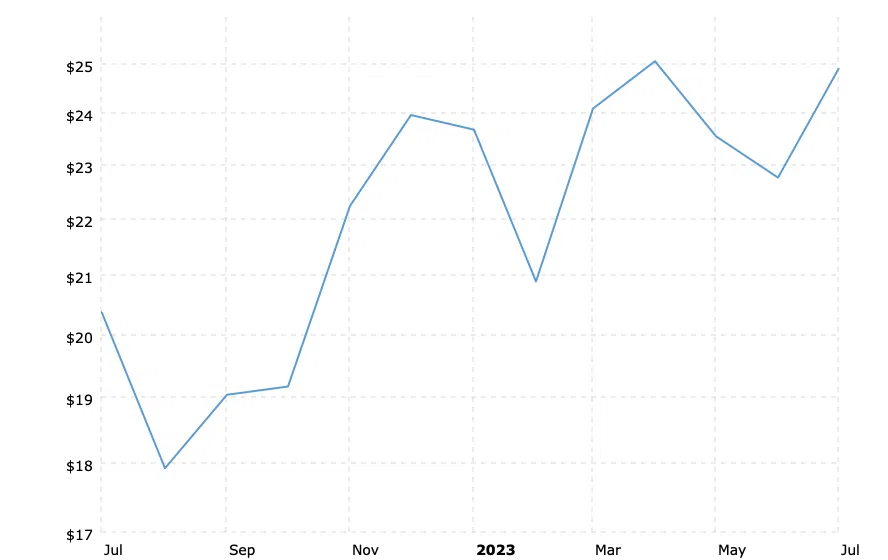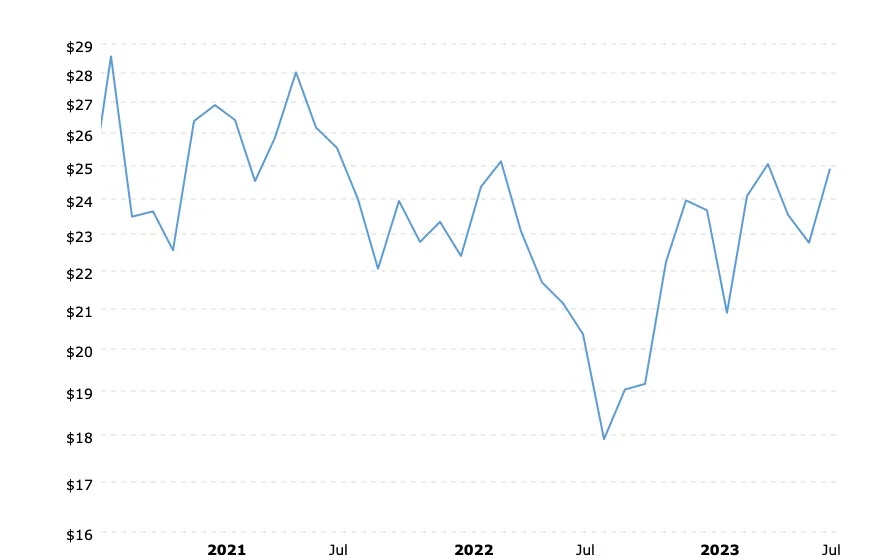How High Can Silver Go?
Silver – how high can it go? The price of silver jumped higher by nearly $2 oz. over a two-day period last week.
The white metal now sits just under $25 oz., and this is depicted on the chart (source) below...
Silver Prices - 1 Year Chart

Wall Street's paper substitute for physical silver, SLV (an ETF), shows a similar pattern...
SLV (Silver ETF) 1 Year Chart
|
|
As of yet, silver has not exceeded its high from earlier this year, but that might happen quickly based on current momentum.
If the silver price surpasses its previous high from this year, it could very well move further upwards towards $30 oz.
The bullish bias of some stackers, marketers, and analysts might lead one to believe that $30 oz. is a foregone conclusion. Maybe, maybe not. Let’s take a look.
MORE CHARTS
Below is a chart dating back to August 2020, when the silver price peaked at $28.50 oz. (monthly average closing price)...
Silver Prices Since 2020

We can see that silver's uptrend since its low one year ago, although impressive, is still part of a longer-term downtrend that is almost three years old.
Before silver can reach $30 oz., it must also break through its previous highs at $28 oz. from 2021 and 2020. Those points could prove much more formidable than this year's previous high.
Here is another silver chart. This one dates back to the price peak in 2011...
Silver Prices Since 2011

At a current price of $25 oz., silver is nearly fifty percent lower than its peak in 2011 of just under $49 oz. A more depressing picture comes from the next chart which is the same as the one immediately above except that the prices are adjusted for the effects of inflation...
Silver Prices (inflation-adjusted) Since 2011

Here we see that silver at $25 oz. is sixty-two percent lower than its 2011 peak. In order for silver to match the $49 price from 2011, its current price needs to exceed $65 oz.
Here is one more chart for some additional perspective...
Silver Prices (inflation-adjusted) Since 1971

The price of silver, since its peak in 1980, has continued to move lower in both nominal and real terms. The January 1980 peak price was $36 oz. (monthly average closing price).
If silver were to rise to $30 oz. it would still be six dollars cheaper than its 1980 peak. In real/inflation-adjusted terms, silver at $30 oz. would still be eighty percent lower than its 1980 peak ($140 oz).
FUNDAMENTALS AND LOGIC
Some insist that the fundamentals (see Gold and Silver - Fundamental Be Damned) for silver will take its price much higher very soon. Those fundamentals involve silver's industrial uses, its role as money, a gap in supply vs. demand, etc.
A counter to that is that most of the fundamental arguments put forth in support of expectations for a higher silver price are the same arguments advanced at every outbreak of silver fever in the past half-century.
History shows that other than spurts of magnitude for brief periods of time at infrequent intervals, nothing has happened that indicates something radically favorable is about to happen for silver.
What's more, the increases in the silver price continually come at lower levels. No matter how fast silver runs, it never recovers the lost ground.
WHAT SHOULD YOU DO?
Silver has already risen by forty percent since last summer. How much profit potential is left? Probably not much.
If you already own silver and have accumulated some profits, then take them.
History shows that the longer you hold silver, the potential for losses increases with time. (see Silver Is A Screaming Bargain and Silver - Dead In The Water For Forty Years)
Kelsey Williams
Kelsey Williams is the author of two books: INFLATION, WHAT IT IS, WHAT IT ISN'T, AND WHO'S RESPONSIBLE FOR IT and ALL HAIL THE FED!
